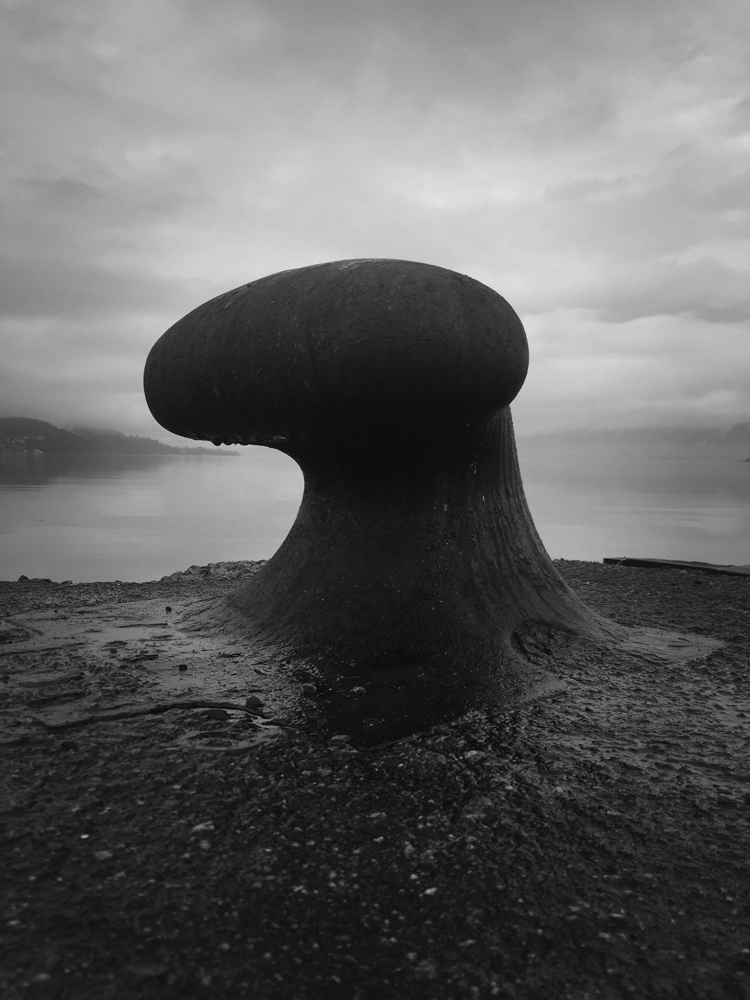Task 2 – Make small things big
Task 2
Make small things big

Trude comes from the place where we had this particular workshop, Sykkylven. She had planned to photograph some of the local characters at the café but since they weren’t there, she turned her attention towards the ferry quay. She had seen it thousands of times. However, now she had to study it and see it in a new light. Aided by her training as a graphic designer, she discovered that the bollard, seen from the perspective of a frog, had an interesting shape. Since it had just rained, there was a nice reflection on the ground and a few hanging raindrops. Trude knows how important details are and she let the drops just about touch the nose in the background. How would this picture have looked if the sun had been shining and the concrete was dry? What if she had moved ten centimeters to the right? Try to imagine that that had happened. Doing this is good practice training for doing the real thing.
SYKKYLVEN, NORWAY, 2016. Photo: Trude Roald
Problem
Becoming blasé
We shuffled away at a snail’s pace on roads lain with mines in Angola. On the side of the road a man stood waving at us. He wanted to know if we could help Mathilde. She had stepped on a mine and half of her right foot had been blown off. The muscles were draped like rags around the bone of her leg. We took her to the Doctors Without Borders’ hospital in Kuito. My encounters with Mathilde and other mine victims were many and powerful. No other city in the world has had such a large proportion of its people injured by mines.
What surprised me the most was that after a week I had become accustomed to the degree that this seemed to be a part of everyday life. At the children’s ward where I worked, I quickly gained new abilities such as being able to predict which two or three children were going to die during the course of a night.
Our brains are designed so that we are able to get used to new circumstances quickly. This is a great advantage for us when we are facing new challenges. However, it is a huge disadvantage for us in our modern lives where most of the things surrounding us would have appeared miraculous only a few generations ago. Now we register these things with a yawn due to the tendency of the brain wanting to see something new and spectacular instead. Friedrich Nietzsche says that this is like someone sitting on a treasure chest and begging. We have become blasé and dissatisfied. If we had achieved everything we had dreamed of, then the brain would quickly get used to it and asked for more. You can get your dream job, marry, get the partner of your dreams, become a millionaire, represent your country on the national team, become an international celebrity…yet still find something to complain about.
This is also applicable when we use a camera due to us easily overlooking normal, everyday things. We take photos when we do something or go somewhere spectacular – on exotic vacations, a family celebration, while we are pursuing an exciting hobby. However, let’s rather explore the ordinary because the camera has the unique ability to make small things big.
What are you overlooking in your everyday life?
How relevant is this issue for you on a scale of 1 to 6?
Solution
See the value in everyday objects
I have held photo workshops in Cuba, Ethiopia, Morocco and Sri Lanka, as well as in Sykkylven, Solund and Hønefoss in rural Norway. People often choose the same subjects while in exotic locations, but in Norway, while we are surrounded by more commonplace things, the pictures become more varied. The personal expression of each participant becomes more visible. Moods, shapes and color that echo from our childhoods emerge. Each photographer finds his or her style and visual expression. People who live in these places say, “Where in the world did you take this photo?” One participant replied, “In your basement!”
The camera has the ability to make small things big, both concretely and figuratively. In a photo, a blade of grass can appear larger than a tree and a fly can look more majestic than an elephant. Similarly, a glass of water on a kitchen counter can outshine a photo of a waterfall in Iceland. A photo with the light falling on your son’s face can eclipse a portrait of an Indian sage. The best pictures are often nearer to us than we think.
When we point the camera at the stuff of our everyday lives, we see colors, shapes and moods that usually slip by unnoticed like the steps to the attic that have been worn down by the feet of our ancestors and the dirty dishes in the sink that still have traces from yesterday’s guests on them. What do you see when you go explore the usual and commonplace? Maybe you will discover that when you look at things with a camera, what you look at changes.
The nature of photography forces us to point our gaze at something that we have and exist, and not something we lack or hope for.
PHOTO ASSIGNMENT:
Stay inside your home or apartment.
Look around as if you were your great-great grandfather on a visit.
Enjoy being able to see and discover with a camera.
How useful was this task for you on a scale of 1 to 6?
BOOK SUGGESTION: Art As Theraphy by Alain de Botton
[note_editor]

